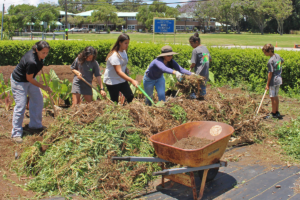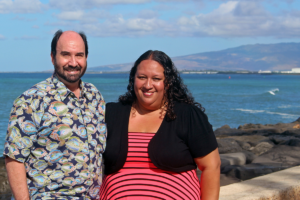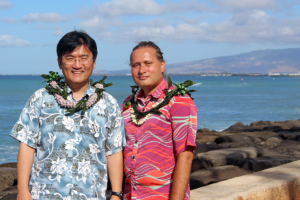IN THIS ISSUE
FOOD: Farmer owned, ‘āina grown: Co-op helps breadfruit make a comeback
WATER: Engaging Hawai‘i’s watersheds to advance scientific and cultural learning
PLACE: Cultivating a sense of place through volunteering
PEOPLE: The Kohala Center awards doctoral fellowships to Native Hawaiian scientist and engineer
Program News
Upcoming Events

Farmer owned, ‘āina grown: Co-op helps breadfruit make a comeback
As The Kohala Center continues to support efforts to increase local food production and security, we often look to the indigenous agriculture practices that provided abundance in these islands for centuries. One of our clients is learning from the past to feed our future by reviving interest in Hawai‘i’s most versatile, nutritious, and sustainable food crop: ‘ulu.
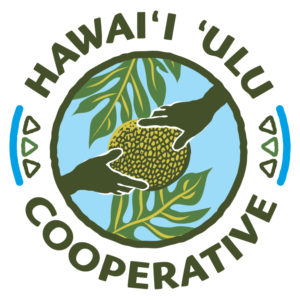 When Māla Kalu‘ulu, a cooperative farm business in Hawai‘i Island’s South Kona district, was just starting up, it began selling ‘ulu (breadfruit) right away but didn’t yet have enough mature trees to meet customer demand consistently. The co-op’s farmers, who employ a traditional Hawaiian agroforestry system featuring ‘ulu trees as a canopy for other traditional understory crops, realized they needed to work with other ‘ulu growers to increase their capacity. After meeting and finding positive synergy with eight other growers from around Hawai‘i Island, coupled with encouragement from the Ulupono Initiative, the Hawai‘i ‘Ulu Cooperative (HUC) was born.
When Māla Kalu‘ulu, a cooperative farm business in Hawai‘i Island’s South Kona district, was just starting up, it began selling ‘ulu (breadfruit) right away but didn’t yet have enough mature trees to meet customer demand consistently. The co-op’s farmers, who employ a traditional Hawaiian agroforestry system featuring ‘ulu trees as a canopy for other traditional understory crops, realized they needed to work with other ‘ulu growers to increase their capacity. After meeting and finding positive synergy with eight other growers from around Hawai‘i Island, coupled with encouragement from the Ulupono Initiative, the Hawai‘i ‘Ulu Cooperative (HUC) was born.
‘Ulu is a low-fat, nutrient-rich fruit that was brought to Hawai‘i by some of the earliest Pacific navigators roughly 1,700 years ago. Unlike other well-known canoe crops such as kalo (taro) and ‘uala (sweet potato), ‘ulu grows on trees that thrive in tropical environments; a single tree can produce more than 1,000 pounds of fruit annually for decades. When planted in diversified agroforestry systems, ‘ulu trees help to mitigate soil erosion, sequester carbon, and provide habitat to wildlife. Their longevity, heat and drought tolerance, low maintenance requirements, and environmental benefits make them one of the most sustainable, resilient crops available. ‘Ulu has been identified as an essential crop that can provide ample sustenance to food-insecure regions and communities most vulnerable to climate change. Depending on the maturity stage, the starchy, low-glycemic fruit can serve as a substitute to potatoes or bananas, and can be prepared in a wide variety of creative, delicious ways. It is often used to make poi and can even be milled into gluten-free flour. Other parts of the fruit and tree have beneficial uses as lumber, mosquito repellent, latex, fabric, and animal feed.
Once the notion of a broader ‘ulu cooperative became viable, Dana Shapiro, HUC’s manager and one of the founding members of Māla Kalu‘ulu, applied for and received funding through the U.S. Department of Agriculture (USDA)’s Local Food Promotion and Specialty Crop Block Grant programs, as well as from Ulupono, to develop the co-op’s infrastructure and marketing, as well as to support member-farmers to expand their operations. By building its current membership of 25 (and growing) small-scale, diversified farms on Hawai‘i Island—based in numerous geographic locations and microclimates with varying harvesting seasons—the co-op is able to offer its products virtually year-round. HUC currently sells whole fruit and frozen one- and five-pound bags of peeled, steamed ‘ulu in a variety of convenient cuts and maturity stages, as well as two value-added products under its ‘Ulu Lā label of ready-to-eat foods: ‘ulu hummus and ‘ulu chocolate mousse.
To help with cooperative formation, legal incorporation, and additional technical assistance, Shapiro turned to The Kohala Center’s Rural and Cooperative Business Development Services team.
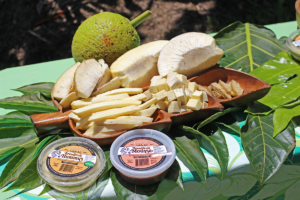
Hawai‘i ‘Ulu Cooperative’s products include fresh fruit, frozen ‘ulu in a variety of ready-to-cook cuts, and its ‘Ulu Lā line of prepared foods such as breadfruit hummus and breadfruit chocolate mousse.
“The Kohala Center’s business services staff has provided us with cooperative development assistance from the very beginning, helping us through the process of forming as a co-op,” she said. “The Center’s network of consultants has also provided us with technical assistance in accounting, legal assistance, food processing, and on-farm food safety to help us continue to improve our co-op’s operations.”
Funding programs such as USDA’s Socially Disadvantaged Groups Grant and Rural Business Development Grant enable The Kohala Center to provide training, consulting, and technical expertise to rural and cooperative businesses throughout the Hawaiian Islands. Through these grants The Center is helping HUC to develop the next generation of its website, which will include an online store, and is providing one-on-one production consultations with its member-farmers to enhance tree maintenance and fruit pruning and harvesting.
“By reinvesting funding support from organizations such as the USDA into the local community, we’re helping Hawai‘i’s rural businesses get off the ground, expand, and succeed,” said Teresa Young, The Kohala Center’s rural and cooperative business development specialist. “The Hawai‘i ‘Ulu Co-op is a natural fit for us because they are promoting a truly local food and making it easier for consumers to access and use, while also using traditional, regenerative agricultural approaches to care for the ‘āina.”
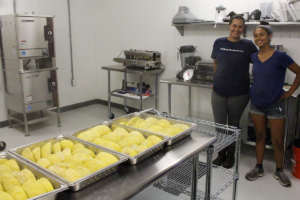
Taimi and Anissa with the Hawai‘i ‘Ulu Cooperative finish steaming ‘ulu at the co-op’s commercial kitchen in Honalō. The ‘ulu are then frozen and packaged in convenient freezer packs and distributed to local schools, hospitals, and restaurants.
In late July the co-op opened a food processing facility in Honalō, just south of Kailua-Kona, in a warehouse owned by the Hawaii Department of Agriculture (HDOA) and managed by The Food Basket, Hawai‘i Island’s food bank. HDOA helped invest in the construction of an on-site commercial kitchen, and the co-op leveraged its own profits and the USDA Local Food Promotion Program grant it received last year to procure food-processing equipment. The Food Basket has been a supporter of HUC since it launched, providing logistical support with deliveries and cold storage and purchasing discounted ‘ulu products for its community-supported agriculture (CSA) program, “Da Box,” every month. The co-op is currently interested in making its Honalō facility available to other area food producers who use ‘ulu in their products.
“We’re really excited to help revitalize this facility as a food hub for West Hawai‘i, and offer a sort of ‘innovation center’ for food producers who use ‘ulu and want to craft new, creative value-added products with it,” Shapiro said. The co-op is now working to establish a dedicated East Hawai‘i hub and processing facility just north of Hilo as well. In the meantime, one of the co-op’s founding members, Sweet Cane Café, serves as its East Hawai‘i aggregation point. The facilities offer convenient drop-off locations for the co-op’s member-farmers and for community members who have ‘ulu trees and might be interested in selling extra fruit. “A single tree can produce hundreds of pounds of fruit each harvest—a lot more than an average family can consume—so we’re happy to buy extra ‘ulu that meets our quality standards. We’d rather see it nourish the community than let it go to waste.”
Farmers and home growers with at least one ‘ulu tree can join the co-op as producers, and non-members can sell their fruit to the co-op at a slightly reduced non-member rate. Contact info@eatbreadfruit.com or 808-238-8869 for membership and sales information, and visit eatbreadfruit.com to learn more about the co-op and its products. You can also follow the co-op on Facebook and Instagram.

Engaging Hawai‘i’s watersheds to advance scientific and cultural learning
Developed by teachers for teachers, our Hawai‘i Meaningful Environmental Education for Teachers (HI-MEET) program provides training and curriculum aligned with Common Core and Next Generation Science Standards (NGSS). The program offers today’s teachers—whose time and resources are often limited— resources to help them give their students meaningful, project-based experience to engage with their natural environments.
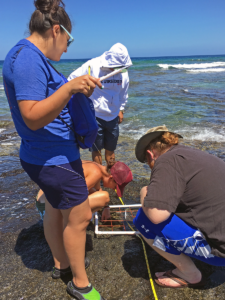
Middle and high school teachers from Kailua-Kona (l-r Viviana Martinez, Kyli Lyn Arford, Alfonso Rivera, and Justin Brown) conduct a tide pool biodiversity field investigation at Paniau using quadrats and transect lines.
HI-MEET is the latest incarnation of place-based field research programs offered by The Kohala Center with the goal of getting Hawai‘i schoolchildren out of their classrooms and into their ahupua‘a (mountain-to-sea land divisions). Research indicates that rural students and underrepresented minorities—particularly those of Hawaiian and Pacific Island backgrounds—are best served and motivated by place-based, project-based, hands-on activities and challenging science instruction, especially when their investigations address real-world problems in culturally relevant terms.
Our current program began in 2016 when a team of master teachers came together to develop and test a middle- and high-school field science curriculum. The result is Huli ‘Āina Kumu Wai, a curriculum that focuses on watershed investigations and includes instruction on field observation skills and sampling techniques along with 14 lessons for schoolyards, forests, and coastal ecosystems. It also features a unique emphasis on place with a focus on embracing Hawaiian cultural protocols.
This year’s program launched in late July with a three-day, hands-on workshop in Waimea for 21 teachers from Hawai‘i Island and O‘ahu. The diverse group of educators teaches a variety of subjects including biological and physical sciences, math, social studies, English, physical education, and special education. During the workshop, participants gained field experience learning how to collect environmental data and use field sampling equipment; practiced implementing lessons in schoolyards, forests and coastal environments; were introduced to regional natural resource partners; and received watershed and ahupua‘a maps to use as teaching tools.

‘Āina-based education specialist Mahina Patterson leads teachers through the “Mapping and Describing a Watershed” lesson.
Teachers practiced their kilo (observation) skills of the clouds, ocean, and land conditions. As their students will this school year, they experienced the three types of field investigations—descriptive, comparative, and correlative—by collecting tide pool species diversity data, comparing urchin species diversity between two tide pools, and seeing whether tide pool proximity to land impacted the tide pool species diversity.
Each participating teacher will receive $200 to purchase field science supplies, as well as ongoing assistance throughout the school year including logistical support, transportation fees, and organizing classroom presentations.
Based on feedback she has received, our environmental education coordinator, Ilene Grossman, says participants appreciated receiving the curriculum guide and the opportunity to practice using the lessons plans. “They really appreciated learning about Hawaiian kilo observation skills and Hawaiian cultural protocols and oli (chants) to establish relationships with natural areas,” she said. “They appreciated the importance of including kama‘āina (residents with multigenerational ties to, or intimate knowledge of, a particular place) and kūpuna (respected elders) in educating their students about place.”
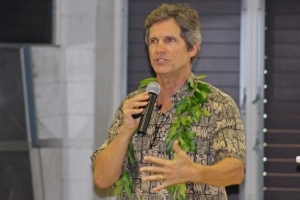
As part of the teacher training workshop, Dr. Chip Fletcher from the School of Ocean and Earth Science and Technology at the University of Hawai‘i at Mānoa gave a presentation about climate change and how it is impacting Hawai‘i. This session was open to the community and is available to view online.
(Part 1 | Part 2)
The diverse teaching team for the three-day workshop included classroom teachers, a wa‘a (double-hulled canoe) navigator-in-training, environmental and ‘āina based educators from The Kohala Center, kama‘āina of the places visited (specifically Puakō and the forests of Kohala Mountain), and Hawaiian natural resource managers. Guest speaker Tina Benson, a veteran science and English teacher from Waimea Middle School, provided guidance on how she incorporates field science projects into her curriculum to foster students’ ecoliteracy. Dr. Chip Fletcher from the School of Ocean and Earth Science and Technology at the University of Hawai‘i at Mānoa gave a presentation about the impacts of climate change and sea-level rise in Hawai‘i, providing recent research and statistics teachers can weave into their lessons. Fletcher’s presentation was open to the North Hawai‘i community and is available to view online.
While the three-day workshop is now complete, there is still exciting work ahead for HI-MEET participants. Teachers will receive two to four classroom visits by science experts who will help students develop and conduct their field research projects, data analysis, and create a final report and presentation. Additional classroom activities will culminate in the teachers and their students visiting outdoor classrooms on guided field trips, where they will participate in scientific investigations and conduct real, place-relevant research.
The HI-MEET program is funded through the National Oceanic and Atmospheric Association (NOAA) Bay Watershed Education and Training (B-WET) Training Program and Kamehameha Schools. Teachers are eligible to receive five professional development (PDE3) credits from the Hawaii Department of Education for their participation.
“This program is a unique partnership that allows students to study and experience Hawaiian watersheds and ecosystems from a scientific perspective,” said Mari Souza, a science teacher at Waikoloa Middle School. “Without this partnership, I feel that many of the students would never see the amazing flora and fauna that exist on their island. I hope that by providing this experience, students use their new knowledge to respect and protect the living things that surround them, and share their experiences with others.”
In evaluating the curriculum workshop, several teachers appreciated the importance of integrating ancestral knowledge and indigenous science with the contemporary science that is primarily taught in classrooms. Kyli Lyn Arford, a chemistry and biology teacher at Kealakehe High School, summed up the experience for many when she said, “There are a lot of people, including educators, who are passionate about this topic and ready to connect place-based learning, native healing, and community collaboration within a scientific context for our students.”
The program will conclude at the end of the school year with a formal scientific conference, at which students will present their research and findings for peer review and discussion.

Cultivating a sense of place through volunteering
Engaging with Hawai‘i’s natural and cultural landscapes on a more intimate level helps us appreciate and take better care of our special island places. In doing so, we begin to understand the challenges we must overcome to improve and maintain a healthier life and environment. From forests ma uka (upland) through farms and gardens to vibrant coral reefs ma kai (at the ocean), The Kohala Center offers island residents and visitors volunteer opportunities that go beyond just lending a hand—they help deepen kinship with the lands and waters that sustain us.
Hahai no ka ua i ka ulula‘au: Rains always follow the forest (‘Ōlelo No‘eau 405)
An estimated 50% of Hawai‘i’s forests have been lost to deforestation, and non-native plants and animals threaten the forests that still exist today. Our small but tenacious Kohala Watershed Partnership (KWP) field crew braves unpredictable weather and rugged terrain to create fenced preserves, manage feral ungulates, control invasive plants, and restore native forests to bring native ecosystems back into balance. With more than 65,000 acres on Kohala Mountain to cover, however, they can’t do it alone.
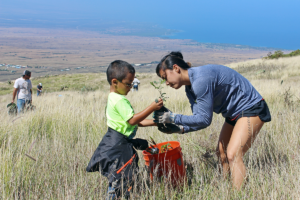
A mother and her young son plant a native koai‘a tree in the Pelekāne Bay watershed on Earth Day 2017.
Liz Kuzman-McRae had just moved to Hawai‘i Island when she signed up for a KWP volunteer day in August. Her cousin, Julia Meurice, is active in local watershed and coastal conservation projects, and encouraged her to volunteer as a way to orient her to the island’s broader ecosystems that surround and sustain island communities. The huaka‘i (excursion) to Pu‘u Pili introduced Kuzman-McRae to one of Hawai‘i’s few remaining native forests, and also helped her understand that the beautiful, fragrant ginger found there threatens native trees, ferns, and mosses that are vital to attracting, capturing, and retaining rainwater and moisture.
“I think it’s important to connect with the land you’re living on,” Kuzman-McRae said. “Becoming part of a community begins with getting to know the environment and space where you find yourself. Today I learned that ginger plants are huge! And what a problem they are, and how building fences in conservation areas can really work wonders in keeping invasive plants and animals out and giving the forest a chance to grow and thrive. This experience has made me an advocate for the work being done to help heal the mountain. It’s absolutely beautiful up there, and I feel privileged to have been able to visit and contribute to an area that’s generally not accessible to the public.”
KWP volunteer days are typically held the first and third Friday of every month, with activities ranging from planting native trees to reestablish native forests and help mitigate soil erosion, to removing invasive plants that can overtake native species and provide fuel for wildfires. “Our volunteers really make a big difference—many hands make smaller work,” said KWP coordinator Cody Dwight. “Volunteers also boost our morale because they bring fresh perspectives and new energy to the work we do. It inspires us to see members of the community caring about the environment around them and investing such energy and passion to help us help the mountain.”
He pūko‘a kani ‘āina: A coral reef that grows into an island (‘Ōlelo No‘eau 932)
Volunteers at our Kahalu‘u Bay Education Center (KBEC) enjoy sunny days working at the beach and in the water to educate visitors about “reef etiquette.” More than 400,000 visitors per year flock to tiny Kahalu‘u Bay to experience its vibrant and colorful corals, fish, and honu (green sea turtles), and in doing so many unknowingly harm the bay’s ecosystem by kicking, standing, and stepping on coral or by trying to touch and feed marine life. As Kahalu‘u Bay’s “ambassadors of aloha,” our ReefTeach volunteers help visitors have a memorable, enjoyable experience while also helping them learn to respect the bay’s fragile habitat.
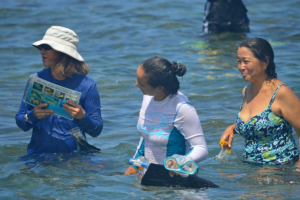
ReefTeach volunteer Colleen Wallis educates visitors to Kahalu‘u Bay about the importance of avoiding contact with coral and the bay’s delicate marine life.
Kailua-Kona resident Colleen Wallis has been a ReefTeach volunteer since 2010, inspired by the program’s focus on keeping Kahalu‘u Bay healthy. “There are many reasons I’m a ReefTeach volunteer, but the main one is because I want to help protect our precious marine life, especially the honu and the coral that are so vital to the bay’s ecosystem,” she said. “I love this island and all the wildlife on it and in the sea, and if we don’t protect our natural resources, there won’t be any more beautiful fish or turtles to see while snorkeling. If we don’t protect what we have, our future generations will not be able to see and enjoy what we have today.”
Our KBEC team relies on volunteers every day to help educate as many visitors as possible. We provide free training and no experience is required—just a desire to help and a spirit of aloha. “Volunteers are the foundation of our program. We wouldn’t be able to function without them,” said KBEC director Cindi Punihaole. “Most visitors who come to Kahalu‘u just want to see the honu and colorful fish. Our staff and volunteers help them understand the bigger picture of how important coral is to a healthy ocean, healthy island, and a healthy planet. If one element in this ecosystem suffers, the whole bay suffers. When people can see Kahalu‘u as a microcosm of their own place, they can take this experience home and hopefully build stronger reverence for the natural world around them.”
Holo iʻa ka papa, kau ʻia e ka manu: Where there is food, people gather (‘Ōlelo No‘eau 1052)
Through our Hawai‘i Island School Garden Network, Foodcorps Hawai‘i, and farmer training programs, volunteers can literally get their hands dirty by maintaining and nourishing the ‘āina that nourishes us. Many school learning gardens in our network welcome volunteers willing to build and maintain these vibrant outdoor classrooms by pulling weeds, starting and turning compost piles, building and repairing garden beds, and enriching the soil to keep it healthy. At our demonstration farm in Honoka‘a, community members can join a quarterly volunteer day and work alongside students in our farmer training programs to learn more about farming, agroforestry, intercropping, and more while tending crops and helping improve soil fertility. Volunteer days at our farm usually include a potluck lunch, and participants can take plants home for their gardens.
“Many of our volunteers come because even though they want to help and make a difference, they also learn new things and take knowledge with them,” said Donna Mitts, our garden educator and program assistant. “While they’re working, they get to ask lots of questions that help them become better gardeners at home or inspire them to start one. By helping out in our outdoor classrooms, they learn the value of mālama ‘āina (caring for the land) so they can practice it where they live.”
Whether you’re passionate about forests, water, the ocean, native plants and animals, local food systems, or wish to deepen your connection to place, The Kohala Center has rewarding volunteer opportunities to suit almost every interest. Visit our Get Involved page to sign up or give us a call at 808-887-6411. Here are a few of our upcoming volunteer opportunities:
Kohala Watershed Partnership Volunteer Days (Waimea, Hawai‘i Island)
Friday, September 22 • 8 a.m. to 1 p.m.: Koai‘a Tree Sanctuary
Friday, November 3 and Friday, November 17 • 8 a.m. to 1 p.m.: Koai‘a Corridor
Friday, December 1 and Friday, December 15 • 8 a.m. to 1 p.m.: Pu‘u Pili
RSVP online at kwp-summer17.eventbrite.com
Aloha ‘Āina Day: Outplanting Native Plant Species (Waimea, Hawai‘i Island)
Saturday, October 14 • 9 a.m. to 1 p.m.: Koaiʻa/Pelekāne Restoration Corridor
RSVP online at kwp-summer17.eventbrite.com
ReefTeach Volunteer Training (Kailua-Kona, Hawai‘i Island)
Saturday, October 21 • 9:30–11:30 a.m.
Email kclark@kohalacenter.org for more information and to sign up

The Kohala Center awards doctoral fellowships to Native Hawaiian scientist and engineer
As communities in Hawai‘i grow and expand to meet the needs of an increasing population, infrastructure and development projects can have an adverse effect on terrestrial and coastal environments. As part of our ongoing efforts to foster intellectual leadership from and for Hawai‘i, The Kohala Center is supporting two Native Hawaiian Ph.D. candidates this year whose dissertations address green infrastructure and sustainable development approaches, and what resilient corals thriving in degraded environments can teach us about life in a changing world.

(l-r) Dr. Robert Richmond, Narrissa P. Spies, Cheryl Ka‘uhane Lupenui, Lelemia Irvine, Dr. Albert S. Kim
Narrissa P. Spies, who is pursuing a doctorate in zoology, and Lelemia Irvine, a doctoral candidate in civil and environmental engineering, will each receive $45,000 and mentorship through the fellowship program to enable them to focus on completing and defending their dissertations during the 2017–2018 academic year. Both are pursuing their doctoral degrees at the University of Hawai‘i at Mānoa.
Formerly known as the Mellon-Hawai‘i Doctoral and Postdoctoral Fellowship Program, our Hawaiian Scholars Doctoral Fellowship Program supports the work of emerging Native Hawaiian scholars who advance knowledge of Hawai‘i’s natural and cultural landscape and Hawaiian history, politics, and society. The one-year fellowships are funded with support from Kamehameha Schools, the Deviants from the Norm Fund, and Dr. Paul and Elizabeth Nakayama.
Since 2008, our doctoral and postdoctoral fellowship programs have awarded $1.57 million in support to 37 Native Hawaiian scholars, many of whom have since received tenure in academic institutions and published original research. “The Kohala Center is committed to cultivating indigenous leadership and increasing the representation and visibility of Kānaka ‘Ōiwi (Native Hawaiian) scholars in academia, research institutions, and publications,” said president and chief executive officer Cheryl Ka‘uhane Lupenui. “We are excited to welcome Narrissa and Lelemia to a larger cohort of distinguished alumni who are advancing ‘ike Hawai‘i (Hawaiian knowledge) for generations to follow.”
Spies was born and raised on Hawai‘i Island and received her bachelor’s and master’s degrees at the University of Hawai‘i at Hilo. Her mentor for the fellowship year is Dr. Robert Richmond, professor and director of the Kewalo Marine Laboratory, which is part of the Pacific Biosciences Research Center at UH Mānoa.
In the face of declining coral health in Hawai‘i and beyond due to rising ocean temperatures, pollutants, and sediment runoff, Spies’ research investigates, at a molecular level, how certain species of coral are thriving despite stress. “I grew up surrounded by the ocean, and it was the focal point of everything I did as a child. The ocean inspired me!” Spies said. “I’ve always loved science and molecular biology, and combining those skills to study coral reefs is the best of both worlds. I shifted to study corals from human cancer, because I felt that there were too few people studying corals, and the threat to them is imminent and immediate.”
After decades of ecosystem degradation in Honolulu Harbor, compounded by a massive molasses spill in 2013, Spies observed two resilient coral species that continue to thrive in the harbor. Her efforts focus on understanding the conditions under which these corals continue to adapt to stress and regenerate, in hopes of unlocking clues that could benefit corals struggling to survive in other parts of Hawai‘i and the world.
“While corals continue to face stress as a result of climate change, these two coral species serve as excellent models for studying the resilience of corals to stress, and may provide insights that can help resource managers in other parts of the world,” Spies said. “My work lays the foundation for understanding resilient coral species, which can hopefully give us clues as to why they’re so well adapted to inhospitable habitats such as harbors. If there are still healthy corals in Hawai‘i in 50 years, I hope it will be because we’ve been able to build off the work I’ve done throughout my Ph.D. and applied this to other corals on our reefs.”
He kupukaaina (a lineal descendent of Wai‘anae, O‘ahu), Irvine received his bachelor’s and two master’s degrees in engineering from UH Mānoa. He is being mentored by Dr. Albert S. Kim, an associate professor in the university’s department of civil and environmental engineering. Irvine’s dissertation focuses on developing a better understanding of low-impact development and green infrastructure approaches. He uses computational fluid dynamics and 3-D modeling techniques to solve engineering challenges to predict process performance of these engineered systems. Irvine’s research will help find new ways to increase sustainable landscapes, communities, villages, and cities.
One particular area of focus examines bioswales technology as a means to improve stormwater management, protect Hawai‘i’s terrestrial and marine ecosystems from non-point source pollutants, and reduce the potential for urban flooding. “My life’s research work in water has taken me to more than 20 countries to learn how to solve challenges in transforming rain’s tears to clean water,” Irvine said. “My work in sustainability merges engineering and culture in an effort to solve some of the daunting problems Hawai‘i faces. Through the mo‘olelo (written and oral narratives) and active mentorship of my ‘ohana (family) and kumu (teachers), I learned that I am descended from great engineers, and I strive to channel their wisdom from within to help bring long life to my ‘ohana, our island communities, and Hōnua (Earth) itself.
“There are many mentors, educators, and kumu that continue to inspire me and have contributed to my intellectual lineage as an engineer. I am most grateful to my master’s advisor, Dr. Ping-Yi and to Dr. Kim, who have guided me to becoming an academic scholar in engineering. My dad, mom, sister, ‘ohana, and Kumu Kalani Akana nurtured my development as a Hawaiian, and Ku‘umeaaloha Gomes inspires my journey as a Hawaiian scientist by instilling the value of giving back to our community through service learning.”
Both of this year’s fellows share a passion for the ocean and reducing pollution that can harm marine ecosystems. As Spies sees it, “We live among one global ocean that connects all of us. We cannot treat the ocean like an isolating barrier, we must realize that our ocean backyard connects us with other Pacific Islands. Hōkūle‘a united us by showing that we are all connected by one ocean, now we need to step up our game and come together to defend our oceans and coral reefs at a time when they need it most.”
We are currently seeking new partners so we may continue to offer these fellowships. To learn more about becoming a partner, contact Cheryl Ka‘uhane Lupenui at ckauhanelupenui@kohalacenter.org or 808-887-6411.
We turn research and ancestral knowledge into action, so that communities in Hawai‘i and around the world can thrive—ecologically, economically, culturally, and socially. We accomplish this through our ‘āina-based programs for community well-being, created in direct response to the expressed needs and aspirations of island residents and community partners. Here’s some of the latest news from our programs and announcements of upcoming opportunities.
FOOD
Hawai‘i Island School Garden Network
-
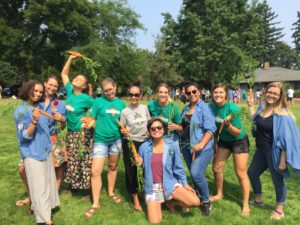
2017–2018 FoodCorps Hawai‘i service members (l-r) Nina Weithorn, Sarah Brown, Laʻakea Kaufman, Laura Cellier, Seri Niimi-Burch, June Guo, Haley Hildebrand, Malia Weisskopf, Riley Theobald, Sarah Strohminger.
Forty-seven K through 8 educators attended our Kū ‘Āina Pā School Garden Teacher Training Program sessions on Hawai‘i Island and O‘ahu this summer. The four-day summer intensives covered our Hawai‘i School Garden Curriculum Map, a guide created in collaboration with island teachers to help peers create standards-based garden programs for their classrooms. Mahalo to our partners Pacific Resources for Education and Learning, ‘Iolani School, Kōkua Hawaii Foundation, and Māla‘ai: The Culinary Garden of Waimea Middle School.
- Congratulations to our 2017–2018 FoodCorps Hawai‘i service members Sarah Vaccaro, Junru Guo, Malia Weisskopf, Nina Weithorn, Riley Theobald, Sarah Brown, Laura Cellier, Laʻakea Kaufman, and Haley Hildebrand. Following a week of training and networking in Portland, Oregon with colleagues and staff from across the country, the one returning and eight new service members assumed their posts at schools on Hawaiʻi Island and Oʻahu. This month they will convene in Kohala for training on curriculum, culturally relevant teaching, and management skills.
Farmer Training Programs
-
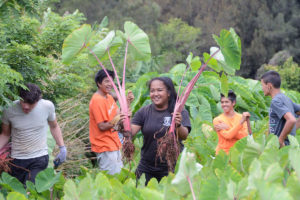
Students in our High School Sustainable Agriculture Program learn about kalo (taro) varieties and harvesting techniques at our demonstration farm in Honoka‘a.
This summer, 11 students participated in our two-week High School Sustainable Agriculture Program, during which they engaged in farm work, farm tours, and service learning visits to give them knowledge of both traditional and contemporary farming systems. Our upcoming one-week fall session will take place October 9–13 from 8 a.m. to 4:30 p.m. at our demonstration farm in Honokaʻa. The program features hands-on training in sustainable agriculture practices and visits to important traditional Hawaiian agricultural sites and farms. Applications are due by September 29.
- AgCurious? GoFarm Hawaii’i @ The Kohala Center will hold a two-hour informational session on its upcoming farmer training programs on Thursday, September 14 from 5:30 to 7:30 p.m. in the conference room at the North Hawai‘i Education and Research Center (NHERC). Cohort 2 of AgSchool starts in November and will run through March 2018. Contact Derrick Kiyabu at derrick@gofarmhawaii.org for more information.
- Our Beginning Farmer-Rancher Development Program (BFRDP) held a seed lecture and workshop in August led by Nancy Redfeather, Lyn Howe, and Glenn Teves. The current BFRDP cohort also went on a field trip to Ka‘ū and visited Michelle Galimba, who introduced the participants to her family-run, 9000-acre cattle ranch, Kuahiwi Ranch.
Rural and Cooperative Business Development Services
-
We partnered with AgriLogic Consulting, LLC and Pacific Gateway Center to host the Hawai‘i Island New Farmer Expo on Saturday, June 17 at Hawai‘i Preparatory Academy. The event was sold out with 115 attendees and 35 vendors and speakers, providing new and beginning farmers with information on resources available to them as they launch agricultural endeavors.
- Congratulations to Hawai‘i Island small business Papa Mū Native Hawaiian LLC for securing a $6,000 Kiva microloan matched by the Hawai‘i Food Producers Fund. The business will use the microloan to develop a USDA-FSIS certified facility authorized to sell traditional imu-style cooked meats. Punachicks Farm, producers of local, organic, pasture-raised chicken, received a $15,000 Kahiau Rural Business Development Microloan for their new processing facility in Kurtistown.
- We’ve been awarded a County of Hawai‘i Economic Development Grant to provide business development and technical assistance to farmers, cooperatives, agribusinesses, and agricultural organizations on Hawai‘i Island. The $25,000 grant award is offered through the county’s Department of Research and Development and will allow us to serve clients in the areas of business planning, record-keeping, cooperative development, financial capitalization, and agricultural production.
Seeds
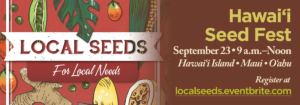 Our Hawai‘i Public Seed Initiative is organizing Hawai‘i Seed Fest: Local Seeds for Local Needs, a community event taking place on Saturday, September 23 from 9 a.m. to noon in Pāhoa (East Hawai‘i Island), Honalō (West Hawai‘i Island), Makawao (Maui), and Waimanalo (O‘ahu). Registration is free but space is limited.
Our Hawai‘i Public Seed Initiative is organizing Hawai‘i Seed Fest: Local Seeds for Local Needs, a community event taking place on Saturday, September 23 from 9 a.m. to noon in Pāhoa (East Hawai‘i Island), Honalō (West Hawai‘i Island), Makawao (Maui), and Waimanalo (O‘ahu). Registration is free but space is limited.
WATER
Kohala Watershed Partnership
- We are currently recruiting for a new field crew leader for our Kohala Watershed Partnership (KWP) program.
-
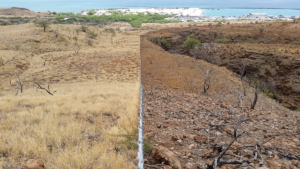
Fences, such as this fenceline installed in the Pelekāne Watershed, keep destructive ungulates from feeding on native plants and groundcover vital to retaining topsoil and mitigating erosion.
We recently received a grant of more than $646,000 from the National Oceanic and Atmospheric Administration (NOAA) to restore the Kawaihae I watershed adjacent to the Pelekane Watershed. Through fencing, ungulate removal, and reforestation efforts, we will be able to stabilize the soil on Kohala Mountain, prevent erosion and sedimentation, protect coral reefs, restore essential fish habitat, and rebuild fish stocks for a variety of marine life, including endangered Hawaiian monk seals.
- Our KWP crew is collecting samples from ‘ōhi‘a trees on Kohala mountain and Waimea Town that exhibit potential symptoms of Rapid ‘Ōhi‘a Death (ROD). Frass samples (airborne saw dust produced by ambrosia beetles digging into trees) are also collected. All samples tested thus far have returned negative.
- We are also working with the U.S. Geological Survey at Pelekane to monitor erosion rates, as well as the Department of Natural Resources and Environmental Management at UH Mānoa to conduct feral cattle counts with drones. The UH research will examine the impact of fencing and non-native ungulates on wildfires.
- Our field crew continues to check 30 miles of fence per month, control invasive weeds and ungulates, and plant native trees. In June the team installed a one-mile fuel break behind the Kailapa Community to protect against wildfires, and excavated 15 sediment check dams in the Pelekane watershed that were filled after the August 2015 fire and flood.
Kahalu‘u Bay Education Center
-
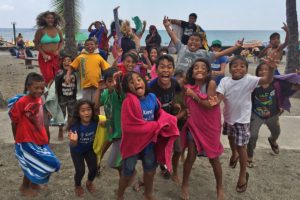
Keiki in our Youth Leadership for Reef Protection program enjoy a day at their beloved Kahalu‘u Bay.
More than 65 keiki in our Kahalu‘u Bay Education Center’s Youth Leadership for Reef Protection program were awarded Certificates of Participation in June. Youth and their families convened for a celebration that included food preparation with chef Ken Guerra and swimming in the bay. In November 2016 participants worked with SNAP representative Adrienne Markworth from Leah’s Pantry (San Francisco) to create seven healthy recipes using familiar Marshallese staples. A cookbook featuring the recipes is available online and a limited number of printed copies are available at KBEC.
- Thirty-five staff members from Kona Coast Resort performed a beach clean-up at Kahalu‘u Bay in August, collecting more than 80 pounds of trash that included 600 cigarette butts.
- Wilderness Adventures and Travel for Teens, summer camp programs for high school students from the continental U.S., visited Kahalu‘u Bay to participate in ReefTeach training and learn about marine science and making Hawaiian crafts.
PLACE
Hawaiian Scholars Doctoral Fellowship Program
(formerly the Mellon-Hawai‘i Doctoral and Postdoctoral Fellowship Program)
-
Dr. Marie Alohalani Brown, a doctoral fellow in the 2012–2013 cohort of our Mellon-Hawai‘i Doctoral and Postdoctoral Fellowship Program, won the top award in the Hawaiian language, culture, and history category of the 2017 Ka Palapala Po‘okela Book Awards. Her first book, Facing the Spears of Change: The Life and Legacy of John Papa ‘Ī‘ī, was based on her dissertation, which she completed with support from her fellowship. Brown currently serves as assistant professor and undergraduate chair in the department of religion at UH Mānoa.
- 2013–2014 doctoral fellow Dr. Kaiwipuni “Punihei” Lipe recently assumed a new position as Native Hawaiian affairs program officer in the office of the chancellor at UH Mānoa.
Ke Kumu ‘Āina
- Ke Kumu ʻĀina wrapped up its first program year in June, engaging 382 students and 39 educators in meaningful, ʻāina-based education focused on agriculture, forestry, and natural resource management. One teacher participant shared, “One of my students, in particular, showed incredible respect and interest in the [Kohala Forest] Reserve. In the classroom, this student often struggled with focusing; however, on our field trip he was so engaged and it was amazing to see him in his element.”
-
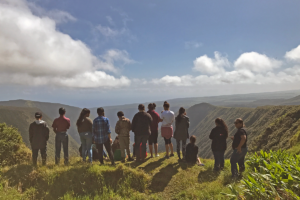
Keiki in our Ke Kumu ‘Āina spring break program overlook Waipi‘o Valley from Alakahi in the Pu‘u o ‘Umi Natural Area Reserve.
For the upcoming fall intersession (October 9–13), we will offer two engaging programs for island youth in partnership with Kamehameha Schools. Our Ke Kumu ‘Āina Alaka‘i ‘Ōpio Program offers high school students leadership and career experience through fieldwork in the Kohala Watershed. Students will be eligible to receive up to $250 for successfully participating in field days and completing additional program requirements, including an education and career pathway plan. The Ke Kumu ‘Āina Fall Break Program offers middle school students opportunities to learn about forestry and watershed conservation. Participants will learn to identify common native forest plants and their uses, understand the environments in which they grow, and engage in scientific field research. Students will enjoy daily field trips into the Kohala watershed, hands-on workshops, and ‘āina-based activities.
- We will launch our new Farm to Forest initiative this month, partnering with four middle schools to engage teachers and students in the propagation and outplanting of native forest plants over the course of two school years. Students will have the opportunity to learn science in a meaningful way while contributing to the restoration of degraded landscapes in their watersheds. Program curriculum and activities will be designed to Hawaii Department of Education standards and HĀ (BREATH) outcomes. Contact our ‘āina-based education specialist, Mahina Patterson, at mpatterson@kohalacenter.org for more information.
September 14
GoFarm Hawai‘i AgCurious Information Session
Honoka‘a, Hawai‘i Island
September 22
KWP Volunteer Day: Weed Control in Koai‘a Tree Sanctuary
Waimea, Hawai‘i Island
September 23
Hawai‘i Seed Fest: Local Seeds for Local Needs
Pāhoa and Honalō, Hawai‘i Island • Makawao, Maui • Waimānalo, O‘ahu
October 9–13
Sustainable Agriculture Program for High School Students
Honoka‘a, Hawai‘i Island
October 9–13
Ke Kumu ‘Āina Alaka‘i ‘Ōpio Program for High School Students
Waimea, Hawai‘i Island
October 9–13
Ke Kumu ‘Āina Fall Break Program for Middle School Students
Waimea, Hawai‘i Island
October 14
Aloha ‘Āina Day: Outplanting in the Koai‘a/Pelekāne Restoration Corridor
Waimea, Hawai‘i Island
October 21
ReefTeach Volunteer Training
Kailua-Kona, Hawai‘i Island
October 28
Record-Keeping Principles for Certification Workshop
Kīlauea, Kaua‘i
November 3
KWP Volunteer Day: Tree Planting in the Koai‘a Corridor
Waimea, Hawai‘i Island
November 4
Farm and Ranch Land Capitalization Workshop
Kapoho, Hawai‘i Island
November 17
KWP Volunteer Day: Tree Planting in the Koai‘a Corridor
Waimea, Hawai‘i Island
December 1
KWP Volunteer Day: Ginger Control at Pu‘u Pili
Waimea, Hawai‘i Island
December 15
KWP Volunteer Day: Ginger Control at Pu‘u Pili
Waimea, Hawai‘i Island


